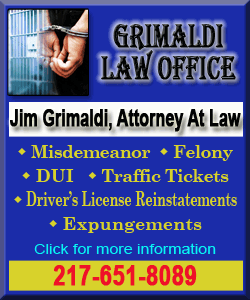 The state of Illinois made it possible in 2007 for schools in a
county to apply for an up to 1 percent retailers' occupation tax, a
"sales tax" on certain goods and services. The tax would be
primarily usable for school facility maintenance and expansion
projects. The state of Illinois made it possible in 2007 for schools in a
county to apply for an up to 1 percent retailers' occupation tax, a
"sales tax" on certain goods and services. The tax would be
primarily usable for school facility maintenance and expansion
projects.Leading up to the referendum in Logan County, schools
offered in return anything from property tax reduction to not asking
for more tax money, in accordance with their current and projected
facility needs.
With the election now certified, the matter has been brought
before the Logan County Board, to whom the authority is given to set
the tax rate by ordinance. The board has the option to set the rate
between 0.25 and 1 percent.
Finance chairman Chuck Ruben brought the committee's
recommendation forward last Thursday that the tax be set at 1
percent.

Board member Gene Rohlfs spoke first, saying that years ago there
was a state occupational sales tax on labor and service. It was
dropped by a 50-year jubilee. But, he said there is again discussion
at the state level to bring that tax back. It would also be at a 1
percent rate.
"We vote the whole 1 percent, and then they (the state) vote
that, and essentially we're at 2 percent," he said.
There was discussion that followed about the low voter turnout
and whether those who did vote actually came out with a commitment
to get this referendum passed and thereby skewed a fair
representation of what Logan County residents would really want.
Andy Meister said, "Yeah, but I think that's the reason we have
elections. We can't go against something because certain people
didn't come out to the ballots."
The discussion took another turn as to whether the school
districts are counting their money from this already. Ruben said he
was sure they are working it into their future budgets now. Most
have a July 1 start on their fiscal year.
However, the taxes begin being collected Jan. 1, 2012, so schools
would not see those tax dollars return from the state until April.
On another facet, Kevin Bateman wanted to know who would be
policing the schools in how they will use the funds. There are
specific guidelines under which those tax dollars can be spent for
building purposes.
"I personally voted against it because I have not seen where the
schools have cut back anything to try to save anything when we're
running double bus routes and we've got superintendents sitting at
every single school," he said.
Vice chairman David Hepler thought that would fall to the
regional superintendent of schools, Jean Anderson.
Ruben said the schools have audits that the state looks at for
how funds are spent.
Bill Martin said that while he was not in favor of a sales tax
increase, "It passed. It passed with the expectation that it would
be at 1 percent."
Rohlfs acknowledged that he had voted against it also, knowing
that when there's a new tax it never goes away.
He recalled that only one school district said it would give
property tax relief in exchange for the new sales tax dollars that
would come in, and that district is talking about buying new
property.
He further thought it would be two to three years before any
return would be made to property owners.
"I think that whole 1 percent will be soaked up," Rohlfs said.
"It'll get used regularly, it'll get planned on, it'll be attached."
He offered, "I'll vote 50-50: half of 1 percent, and no more."
[to top of second column]
 |

Terry Carltion joined Rohlfs, having watched how the schools have
been spending. If you give public bodies more, they spend more, he
said.
"If you give them 1 percent, they're going to spend it all. The
problem is, they grow their liabilities instead of mitigating those
things. They don't lower their costs," he said.
Carlton's perception was that they (the schools) feel they have
to spend what they have coming in.
Agreeing, he said he'd vote for half a percent and would like to
see how responsible the schools are with that amount.
It was required to be put on the ballot as the maximum amount
that it could be voted, which was 1 percent.
Ruben said the schools were aware that it would be up to the
county board to set the amount if the referendum would pass.
"We're not imposing it," he said. "We're setting the rate."
Jo Daviess has been the only Illinois county that set the rate at
less than 1 percent.
A verbal straw vote of board members for 1 percent seemingly,
narrowly passed.
The motion could be amended Tuesday night.

During the campaign to pass the referendum, school administrators
weighed in on what their needs would be and either committed that
the sales tax would be used to pay down current loans on
construction and property maintenances projects, be used for near
future projects, and would either reduce property taxes or keep them
from going up.
LCHS Superintendent Bagby said his board had put in writing that
they will lower their property tax levy and that West Lincoln-Broadwell
made a similar pledge.
At Mount Pulaski, schools pledged to use half the sales tax
revenue to lower property taxes and half for new construction or
renovation on the aging sections of the high school.
Lincoln's District 27 Superintendent Mary Ahillen had the longest
list of projects and said that the sales tax would allow the work to
be done without raising property taxes.
Chester-East Lincoln School needs a boiler and then would work to
reduce property tax levies.
If the ordinance would pass on Tuesday evening, it would be put
on display 30 days and then be sent to the state in June. The board
has until Oct. 1, 2011, to pass this. It would go into effect Jan.
1, and schools would begin seeing the revenue from it in April.
[By
JAN YOUNGQUIST]
Related links
|